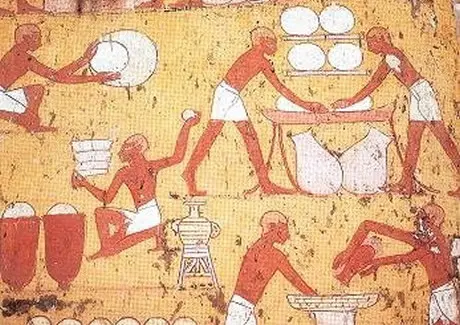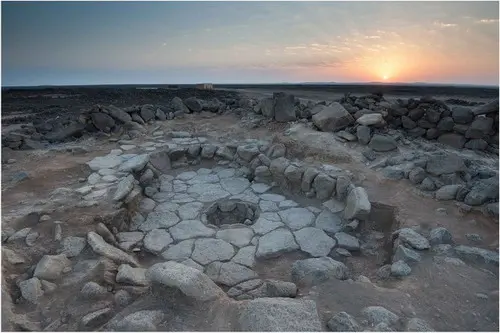This site uses only a few technical cookies necessary for its operation. By continuing to browse, you accept their use.
To find out more...
To find out more...
The first breads of humanity?

I have already told you in a previous article the beautiful story of the croissants, but do you know what it is about the bread, who "invented" it, where and when?
Well, you can imagine that recent discoveries, in 2018, have profoundly changed the history of bread.
Well, you can imagine that recent discoveries, in 2018, have profoundly changed the history of bread.
14 K 5/5 (14 reviews)
Keywords for this post:HistoryBreadPrehistoryExcavationsExplorationLast modified on: February 16th 2019
The first breads of humanity?
Until recently I had, and maybe you do too, the story of the Egyptians (-4000 BC), who used to eat mainly some kind of pancakes, made with a cereal porridge and then cooked in the oven. One day, according to the legend, a cake was forgotten, fermented and leavened, and instead of throwing it away, they decided to cook it anyway. Surprise, it was better than the patties. Bread had just been invented.
I love these beautiful stories or legends, easy to remember and always well timed. How they have survived the centuries? Mystery, but they are there.
So, the bread is the Egyptians, around 4000 BC? Not so simple... One could say that for bread to be invented, agriculture had to be invented, and in particular the cultivation of cereals?
But agriculture began around 11,000 years ago in the Fertile Crescent, an area that straddles Iraq, Turkey, Jordan, Israel, Egypt and Iran of today.
These seeds were crushed between 2 stones or in mortars, then roasted and eaten. Long before the Natufians, around the Lake of Tiberias in Israel, traces of a fireplace with wild barley and roasted starch were found in a cave dating back to 22,000 years ago.
What about bread?
The Natufians at one time settled in the Wadi rum, the black desert of Jordan, at the time fertile and watered.
In this desert, on the excavation site of Shubayqa 1, we found a hearth, in the center of the photo, not yet an oven, with remains of cooking, burned, which have crossed the millennia.
Many questions remain unanswered after this extraordinary discovery, and in particular if the fact that the bread has little leavened is a choice of the Natoufians or an emergency of the time (we had to leave, and quickly)? Which, by the way, makes a beautiful parallel with the flight of the Hebrews from Egypt and unleavened bread, millennia later.
From all this, I think we should remember several things:
If you want to know more about it, I invite you to listen to the episode of Jean Claude Ameisen's fascinating program on France-Inter "Sur les épaules de Darwin" (On Darwin's shoulders) dedicated to the history of bread, only in french.

I love these beautiful stories or legends, easy to remember and always well timed. How they have survived the centuries? Mystery, but they are there.
So, the bread is the Egyptians, around 4000 BC? Not so simple... One could say that for bread to be invented, agriculture had to be invented, and in particular the cultivation of cereals?
But agriculture began around 11,000 years ago in the Fertile Crescent, an area that straddles Iraq, Turkey, Jordan, Israel, Egypt and Iran of today.


These seeds were crushed between 2 stones or in mortars, then roasted and eaten. Long before the Natufians, around the Lake of Tiberias in Israel, traces of a fireplace with wild barley and roasted starch were found in a cave dating back to 22,000 years ago.
What about bread?
The Natufians at one time settled in the Wadi rum, the black desert of Jordan, at the time fertile and watered.

In this desert, on the excavation site of Shubayqa 1, we found a hearth, in the center of the photo, not yet an oven, with remains of cooking, burned, which have crossed the millennia.

Many questions remain unanswered after this extraordinary discovery, and in particular if the fact that the bread has little leavened is a choice of the Natoufians or an emergency of the time (we had to leave, and quickly)? Which, by the way, makes a beautiful parallel with the flight of the Hebrews from Egypt and unleavened bread, millennia later.
From all this, I think we should remember several things:
- Baking preceded agriculture, and not the other way around, in other words, the first men did not wait to cultivate cereals to make bread, they first baked, and only then did they plant and harvest cereals, thousands of years later.
- The first bakers in the history of mankind were therefore probably Natufians, in present-day Jordan.
- Bread is a food that has accompanied humans since the dawn of time, it is the source of life and evolution of our species, we must never forget it.
If you want to know more about it, I invite you to listen to the episode of Jean Claude Ameisen's fascinating program on France-Inter "Sur les épaules de Darwin" (On Darwin's shoulders) dedicated to the history of bread, only in french.
Lasts posts
Butter vs. grease
We often read in a recipe where a pastry is put into a mould that, just before pouring, the mould should be buttered or greased. But what's the difference between these 2 terms?December 1st 20251,8545
Getting out of the fridge early
Very often when you're cooking, you need to take food or preparations out of the fridge, to use them in the recipe in progress. There's nothing tricky about this: you just take them out of the fridge and use them, usually immediately, in the recipe. But is this really a good method?November 24th 20251,3585
Who's making the croissants?
When you look at a bakery from the outside, you naturally think that in the bakery, the bakers make the bread, and in the laboratory, the pastry chefs make the cakes. It's very often like that, with each of these professions having quite different ways of working, but sometimes there's also one...November 23th 20251,255
Oven height
When we put a dish or cake in the oven, we naturally tend to put it on the middle shelf, and that's what we usually do. But in some cases, this position and height can be a little tricky, so let's find out why.October 8th 20253,7525
The importance of sieving
In recipes that use a fine powder (flour, powdered sugar, etc.), you'll often see the advice to sift before using it. To sift is to pass the powder in question through a sieve (a very fine strainer) before incorporating it into your recipe. It's often advice, but is it really useful?September 3rd 20258,2283
Other pages you may also like
Candied fruits: don't get ripped off
Do you like candied fruit? You might like to nibble a handful or add it to a recipe, like a classic fruit cake or delicious Italian specialities like panettone or sicilian epiphany pie.June 21th 201768 K 24.2
The 3 kinds of meringue
Meringue – what could be simpler? Just beaten egg whites with sugar added. This makes a fairly stiff mixture which can then be cooked in a cool oven to create those lovely, light confections. But in the world of professional patisserie, meringue comes in three different kinds. Even if the...June 14th 201365 K4.5
Cooking time for pasta
What is as good and simple as pasta? Not much, I think, and it's so easy to prepare: boiling water, salted (or not, depending on your taste), a few minutes of boiling and it's ready. The only "difficulty", so to speak, is the respect of the cooking time and the risk of, unfortunately, overcooking...July 18th 201924 K4.6
Zester like a pro
Have you heard of the microplane? It's an extraordinary tool that allows you to grate very, very finely, and therefore zest with disconcerting ease. Here's some information about it.December 25th 20208,6244.9
Unmoulding cakes while hot
When you make a cake, pound cake or whatever (what bakers call a "travel cake" because it's easy to carry around) you've most likely made a batter, either by hand or in a food processor, which you then pour into a buttered pan. It's a classic, and I've already talked to you about 2 or 3 tips on...February 6th 202139 K4.6
Post a comment or question
Follow this page
If you are interested in this page, you can "follow" it, by entering your email address here. You will then receive a notification immediately each time the page is modified or a new comment is added. Please note that you will need to confirm this following.
Note: We'll never share your e-mail address with anyone else.
Alternatively: you can subscribe to the mailing list of cooling-ez.com , you will receive a e-mail for each new recipe published on the site.









